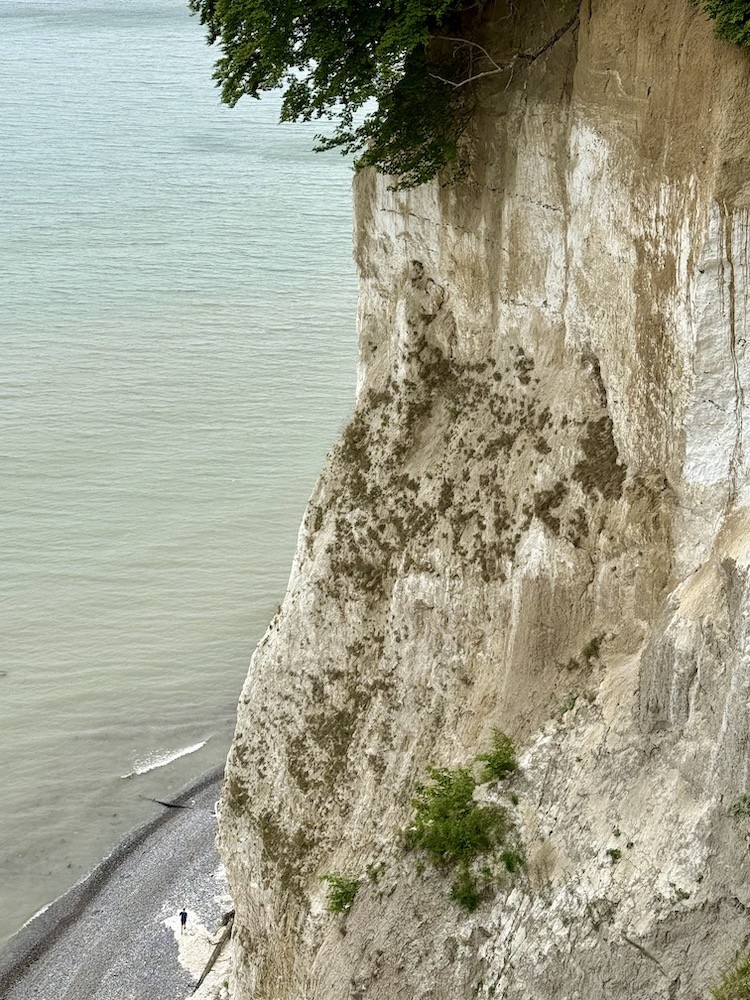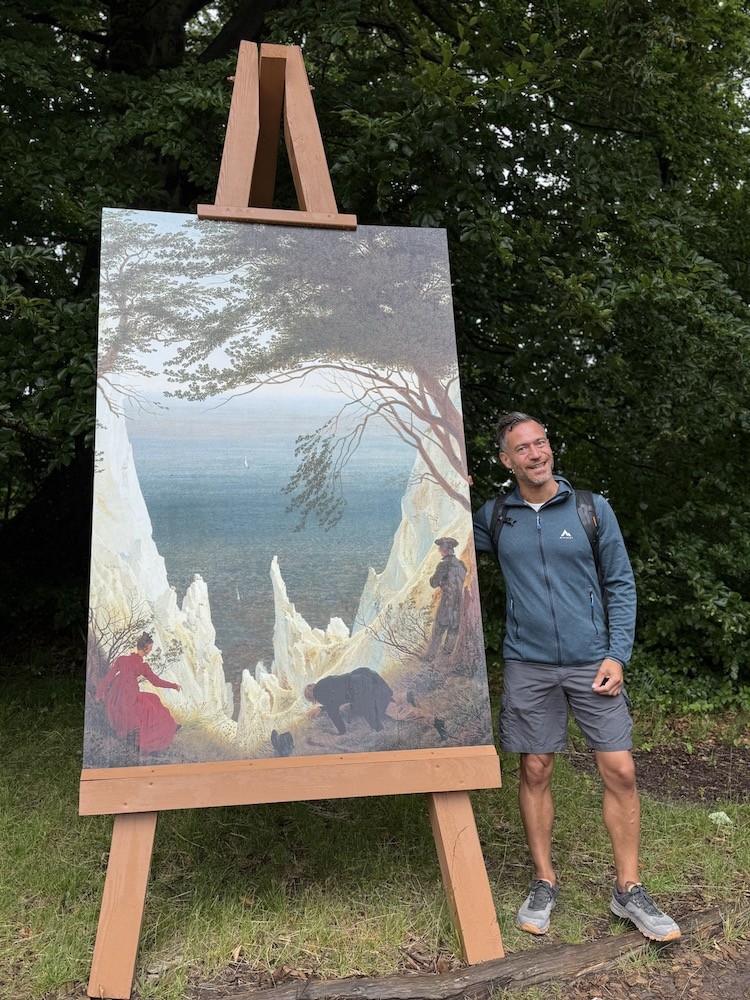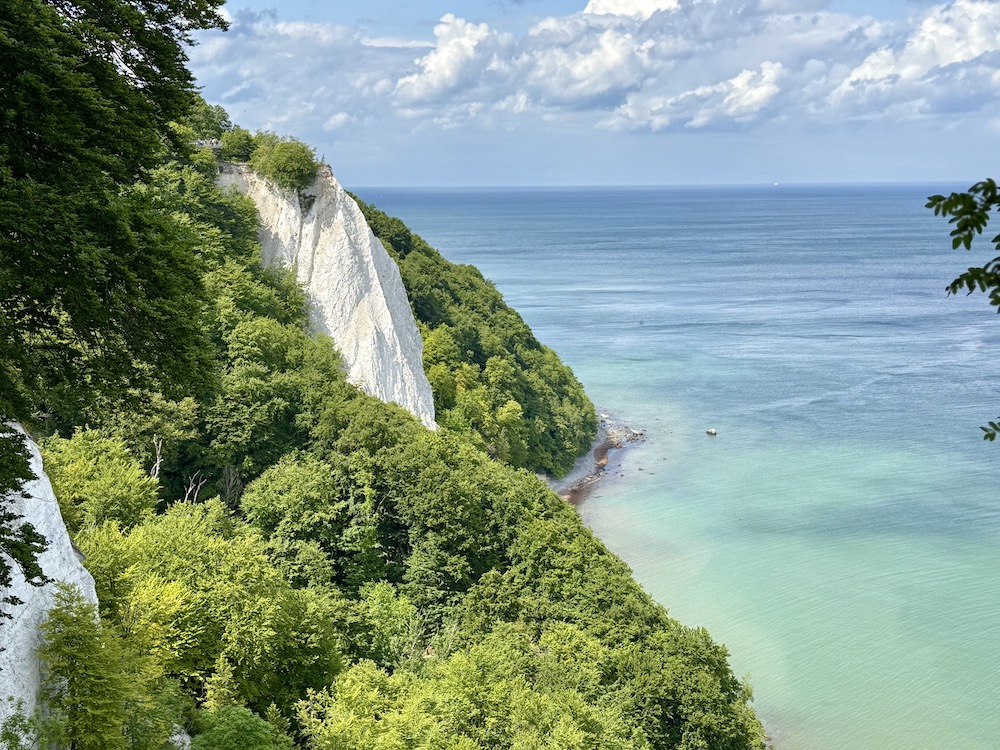Along chalk white cliffs – on foot along the Hochuferweg on Rügen
Van station Sassnitz naar het einde van de wereld
There are those hiking trails where time seems to stand still for a moment. The Hochuferweg along the steep north coast of the island of Rügen is one of those. A day trip full of chalk cliffs, ancient beech forests, seascapes and the feeling of walking at the end of the world – and it all starts at the ‘end of the line’… station Sassnitz on the Ostsee island of Rügen.
The journey to Rügen already starts in style in Stralsund. In the station hall, murals give an overview of the island, including idyllic scenes – chalk cliffs, fishing villages and lighthouses – as a foretaste of what is to come. From this old Hanseatic town, the regional train leaves for Sassnitz, a leisurely 55-minute ride.
Soon after departure, the train crosses the Ziegelgrabenbrücke, an impressive swing bridge built in 1936 specifically to make Rügen accessible by rail. Together with the connecting Rügendamm, it was the only fixed connection to the island for decades. The train then rolls at a leisurely pace across the island, past lakes, forests, fields and occasional water on both sides. The pace is slow, the atmosphere calm – a real Inselbahn or beach train. Not a fast connection, but a journey that does justice to the landscape. Thus, the island feeling starts on the way.


Sassnitzstation – end of the line, start of route
Sassnitz station is located slightly above the town, up against the hill – a modest brick building with a touch of grandeur from days gone by. In the GDR period, this was an important international railway junction: this is where passengers transferred to the ferry to Trelleborg, Sweden, via the legendary ‘Königslinie’. The tracks then literally ran all the way to the ferry. Nowadays it is quieter, but you can still feel something of that history. The platforms are quiet, overlooking the Baltic Sea in the distance and the chalk-white cliffs behind you. From here you can walk straight into the town or towards the coast and the Jasmund National Park. The station is not a destination in itself, but rather a place where past and nature meet quietly – exactly like Rügen itself.


Sassnitz itself is worth a visit, with its long pier, an old fishing port and striking GDR architecture in soft pastel colours. But the real magic begins as soon as you walk out of the town, into the woods towards the coast.
The Hochuferweg – hiking above the sea
From the station, you can easily follow the signs to Nationalpark Jasmund and the Königsstuhl. The route runs about two kilometres through the town and you can schedule a short stop in the historic Altstadt, some narrow streets with colourful gables and cobblestones. Here you will also find several cafés and waterside terraces – perhaps a last coffee before heading into the woods.
Right on the edge of the town is Germany’s smallest national park: National Park Jasmund, with its white chalk coastline, blue sea and green beech forests – a pristine piece of nature that has been declared a UNESCO World Heritage Site.



The Hochuferweg is well-signposted and soon winds up along the steep chalk coast. You walk above Rügen’s famous white cliffs, which once inspired painters such as Caspar David Friedrich. The path takes you through ancient beech forests, some up to 300 years old, part of the UNESCO World Heritage Site. The trees were able to develop as a forest ecosystem for over 800 years, without human felling. The tree branches crackle gently in the wind, the foliage filters the sunlight and every time the forest gives way, you are suddenly face to face with the sea – dozens of metres below.


In some places, you are warned ‘Abruchgefahr – Betreten verboten’. This is because the coastline here is constantly changing. The Baltic Sea gnaws at the foot of the chalk coast. It washes away chalk, moves stones and sand, and drags fallen trees into the sea. Not infrequently, many thousands of cubic metres of sediment slide up to 150 metres into the sea within seconds. After heavy rainfall, dangerous erosions can also occur. But if you stay on the main paths, there is little danger.


Taking time for the views (and the beach)
Although the distance (about 10 kilometres) is fine in two and a half hours, this route deserves a slower pace. The variety is what makes this walk so special: forest and coast, light and shade, silence and the eternal rushing of the waves below. Take your time at the viewpoints – such as the Victoria-Sicht or the Ernst-Moritz-Arndt-Blick – where you look deep into the blue-green chasms and the chalk-white walls stand out brightly against the sea. And occasionally take time for a descent to the beach, where you can walk right past the chalk cliffs.


It is almost unbelievable: the chalk cliffs of Jasmund tell a story that goes back 70 million years. The white chalk layers are interspersed with sand, clay, stones and boulders. That mix of layers may seem random, but each piece reveals something of what has happened here over time. From primordial seas to ice ages, the coast has been shaped by enormous forces and changes you can hardly imagine. Walking along the rocks, you are actually walking through an open book of ancient earth history – and that makes this landscape extra special.

In several places, narrow paths lead down towards deserted beaches among the rocks. Perfect for a break, a picnic, or a quick dip in the water. And the further you walk, the quieter it gets. Most day trippers stick to Sassnitz or Königsstuhl – those who walk the whole route, especially outside the high season, have the most beautiful stretches almost to themselves.
End point: the Königsstuhl and the Nationalpark-Zentrum
After about four hours of walking, you reach the symbolic end point: the Königsstuhl, literally the ‘king’s chair’ – an imposing 118-metre-high chalk cliff that towers over the sea like a white crown. Here you will also find the Nationalpark-Zentrum Königsstuhl, where there is a lot of interesting things to discover about the geology, nature and history of the area. A highlight is the film‘Die Stimme des Waldes‘, which shows how wonderful the forest really is. The film focuses on the experience of the forest as a living organism – including the idea that trees are connected through a kind of “forest network”, also called the Wood Wide Web. As it turns out, trees are not silent giants, but part of a living network underground. Through their roots and a web of fungal threads, they exchange nutrients, warn each other of danger and even seem to look after their “offspring”. The forest lives, feels and works together. After watching this impressive film, at least we walked under those ancient beeches with a very different feeling.


A second highlight: the skywalk, a glass platform above the precipice, where you can look over the edge (literally). An impressive structure. Likewise, you can take a selfie with Caspar David Friedrich’s famous painting “Kreidenfelsen auf Rügen”.
Those who want can also catch their breath at the café here, or travel back to Sassnitz or the main road by Bus 23 (every 30 minutes). But the best thing remains, of course: walking back, under the trees, in the golden evening light.
🧭 Practical info
The Hochuferweg is one of the most beautiful coastal walks in Germany – and a unique combination of nature, culture and silence. Here, you literally stand on the edge of land and sea, with the waves below you and ‘above’ you the eternally blowing beech trees. Perfect for a day trip, ideal for slow travel, and super easy to reach by train and connecting ov.
- Starting point: Sassnitz station (directly accessible by train from Stralsund)
- End point: Königsstuhl / Nationalpark-Zentrum Jasmund
- Distance: approx. 10 km
- Walking time: 2.5 hours of pure walking, but allow 4-5 hours for breaks and ‘detours’ to the beach
- Difficulty: A reasonably light walk with some steep sections
- Tip: Bring snacks, water and swimming gear!
Bus Sassnitz – Königsstuhl
From Sassnitz station, bus 23 runs every 30 minutes to Königsstuhl (24 min), and vice versa. So you can also start at the Nationalpark-Zentrum Jasmund and walk the route back to the station.
For sports enthusiasts, this walk can also be done as a day trip from Berlin. There is a connection departing around 6.30am, arriving 10.30am with 1 x change in Stralsund. And the return trip, also with 1 x change in Stralsund, at 7pm. From the Nationalpark-Zentrum, bus 23 returns to Sassnitz station every 30 minutes. These connections, as well as bus 23, are all included with the Deutschland Ticket.




Leave a Comment